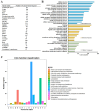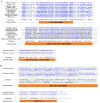Identification of Proteoforms Related to Nelumbo nucifera Flower Petaloid Through Proteogenomic Strategy
- PMID: 39846635
- PMCID: PMC11755666
- DOI: 10.3390/proteomes13010004
Identification of Proteoforms Related to Nelumbo nucifera Flower Petaloid Through Proteogenomic Strategy
Abstract
Nelumbo nucifera is an aquatic plant with a high ornamental value due to its flower. Despite the release of several versions of the lotus genome, its annotation remains inefficient, which makes it difficult to obtain a more comprehensive knowledge when -omic studies are applied to understand the different biological processes. Focusing on the petaloid of the lotus flower, we conducted a comparative proteomic analysis among five major floral organs. The proteogenomic strategy was applied to analyze the mass spectrometry data in order to dig out novel proteoforms that are involved in the petaloids of the lotus flower. The results revealed that a total of 4863 proteins corresponding to novel genes were identified, with 227 containing single amino acid variants (SAAVs), and 72 originating from alternative splicing (AS) genes. In addition, a range of post-translational modifications (PTMs) events were also identified in lotus. Through functional annotation and homology analysis with 24 closely related plant species, we identified five candidate proteins associated with floral organ development, which were not identified by ordinary proteomic analysis. This study not only provides new insights into understanding the mechanism of petaloids in lotus but is also helpful in identifying new proteoforms to improve the annotation of the lotus genome.
Keywords: Nelumbo nucifera; new proteoforms; petaloidy; proteogenomics.
Conflict of interest statement
The authors declare no conflicts of interest.
Figures








Similar articles
-
Comparative transcriptomic analysis provides insight into carpel petaloidy in lotus (Nelumbo nucifera).PeerJ. 2021 Oct 25;9:e12322. doi: 10.7717/peerj.12322. eCollection 2021. PeerJ. 2021. PMID: 34754621 Free PMC article.
-
Genome-Wide DNA Methylation Profiling in the Lotus (Nelumbo nucifera) Flower Showing its Contribution to the Stamen Petaloid.Plants (Basel). 2019 May 20;8(5):135. doi: 10.3390/plants8050135. Plants (Basel). 2019. PMID: 31137487 Free PMC article.
-
Transcriptomic analysis identifies the key genes involved in stamen petaloid in lotus (Nelumbo nucifera).BMC Genomics. 2018 Jul 27;19(1):554. doi: 10.1186/s12864-018-4950-0. BMC Genomics. 2018. PMID: 30053802 Free PMC article.
-
Comprehensive Analysis for GRF Transcription Factors in Sacred Lotus (Nelumbo nucifera).Int J Mol Sci. 2022 Jun 15;23(12):6673. doi: 10.3390/ijms23126673. Int J Mol Sci. 2022. PMID: 35743113 Free PMC article. Review.
-
The Latest Studies on Lotus (Nelumbo nucifera)-an Emerging Horticultural Model Plant.Int J Mol Sci. 2019 Jul 27;20(15):3680. doi: 10.3390/ijms20153680. Int J Mol Sci. 2019. PMID: 31357582 Free PMC article. Review.
References
Grants and funding
LinkOut - more resources
Full Text Sources
Research Materials
Miscellaneous

